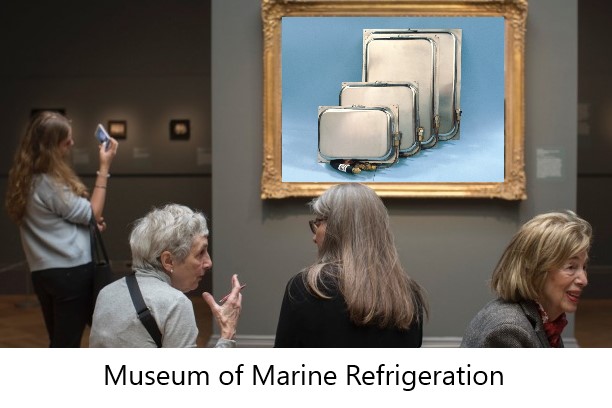Phone: (301) 352-5738
Email: info@CoastalClimateControl.com
Office | Warehouse:
1598 Whitehall Road, Suite D
Annapolis, Maryland 21409
Challenge your Limits
Are you ready to consider Lithium-Iron-Phosphate batteries (LiFePO4) for your boat or RV? Do you want to make a long-term smart investment for cruising enjoyment, giving you one less thing to worry about – dead batteries or not enough battery power for your DC load, i.e. power hungry equipment on board like a microwave, air conditioning, or electric engine?
Why you shouldn’t run your Frigoboat Keel Cooled system out of the water
“You’ve been a very naughty boy, Tompkins, and you must take your punishment. Disobedience has consequences.” So says the headmaster in a typical schoolboy romp in the boys’ magazines of my youth. A few whacks from a cane and life goes on, although these days I suspect it might be a virtual whacking incorporating a VR headset.
Unfortunately, some misdeeds require considerably more than just a simple fix, especially some of the mistreatment we see Frigoboat systems subjected to. Sometimes it’s accidental, sometimes it’s over-enthusiasm, but sometimes people also simply ignore the manufacturers’ instructions.
And so it came to pass that the days of the holding plates in marine refrigeration systems has come to an end. Amen to that!
Our “collection” of these expensive, heavy, and cumbersome hunks of stainless steel is now destined for the scrap pile. This long overdue but necessary move will free up valuable warehouse space for more of the aluminum flat-plate evaporators that have all but replaced the holding plate.
But for those of you unfamiliar with these items we should look at what exactly a holding plate is/was.
Office pranks, cicadas, and supply issues: what do they have in common?
It was indeed an enlightening time being an apprentice with the British national phone system back in the early ‘70’s. In those days the phone company was a branch of the General Post Office (GPO), but soon to become British Telecom (BT).
Apprenticeships were common back then, and at the GPO, Technicians in Training (yes, seriously) like yours truly were shuffled around the many departments to get a feel of who does what. One memorable day this gawky TiT, in poorly fitting baggy overalls, seconded to the heavy-duty pole-erecting gang, was sent off to the stores. Together with other items, I was instructed to pick up a weight as one of our requirements for the forthcoming day’s work. But not just any weight the foreman emphasized, it had to be a long weight.
As summer gets closer and the air heats up, we’re hearing that familiar question again – Can I run my boat’s air conditioner from my battery bank?
Recently we witnessed scenes of euphoria in mission control for the Mars 2020 mission as it gently lowered its Perseverance rover on to the surface of Mars. A fantastic achievement indeed, and the subsequent celebrations were thoroughly justified.
But spare a thought for what must have been a very different scenario for a similar occasion 22 years previously.
As tough a job as it is, trying to sell air conditioning and refrigeration up north here in the midst of ice storms, arctic blasts, and brass-monkey weather, is nothing compared to installing the stuff in those sorts of conditions.
I had a bit of hard job the other day trying to explain the workings of a solar panel to a colleague, and it got me searching for a suitable analogy. Yes, there is the well-used comparison of water to electrical flow, but that’s a tad drippy and wishy-washy in my view, and I was looking for something more illustrative and fun.
So, how about this:
So, let’s say that you bought a 16,000 Btu air conditioner from Coastal Climate Control and politely rejected our suggestion to add an EasyStart compressor soft start device. Then, the first time you try starting it from your aging Ohno generator it issues a disturbing death-like groan as the compressor tries to start, and then the poor thing pops its breaker. So, what just happened there?
Is variable speed marine air conditioning really worth it?
OK, I admit it. I’m a graphaholic. I can’t turn the pages of a newspaper without studying each and every graph and chart, regardless of the subject matter. I make them, I dream of them, and I get itchy if I don’t pore over a graph or two for a few days. (Today I studied one showing the rate of decline in teenage marriages in Bangladesh since 1970). But I’m also acutely aware that the accuracy of any conclusions gleaned from graphs and charts are totally dependent on the validity of the data they are constructed from. Remember; Garbage in - Garbage out.
I turned to graphs recently in my quest to ascertain whether employing variable speed compressors in self-contained marine air conditioning units (i.e. compressor, blower and other bits and bobs all together on one base) really has any great benefits, especially considering the considerable extra cost and complexity involved.
Compared to a contemporary self-contained unit, a variable speed model requires the addition of a number of special sensors plus an electronically controlled expansion valve, all feeding data into a specialized electronics package that powers a three-phase compressor.
There’s a lot to go wrong there, and no way to jury-rig an override if the electronics suffer premature death from water ingress, lightning, or even just plain ol’ electrickery.
How’s everyone been out there? Hopefully, all are well and still kicking and screaming. I’m still lying low and pretty much operating under the radar, but I’ve been badgered lately to get fingers tapping on the keyboard again.
With winter approaching, and with the thought of storms and power outages energizing my little gray cells, I got to wondering just how long I could power up some essentials in the house using my Chevy Volt sitting in the driveway as a power plant.
Oh yes, it’s totally possible, there are tales from those who have done so on the internet, and there are even kits available.
My Volt has a 17 kW-hr, 300v traction battery along with its DC generator plus a 12v battery for all the other normal loads. This 12v battery is charged by a DC-DC converter between the two batteries, so if I were to hook up an inverter to this battery I could supply 110v AC mains power to my household essentials during a power cut, or maybe power up an outdoor event, or fire up a blender and mini-fridge at a beach romp.
Possible? Yes, but for how long?
The debate rages on. Which is best: air cooling or water cooling for marine refrigeration systems?
A refrigeration system doesn’t “make cold”, it removes heat from one area and transfers it to another. There is actually no such thing as “cold”, just heat at different temperatures: cold heat, warm heat, hot heat, etc.
In our small marine refrigeration systems, this heat transfer is accomplished using a compressor and a refrigerant to collect heat from inside an insulated space and disperse it somewhere else via the magic of latent heat. The evaporator is the “heat collector” inside the insulated box while the condenser is the component that disperses that heat elsewhere. While the evaporator is specific for the size and configuration for the application, there are choices to be made regarding condensers and the medium they disperse the heat into.
But first, let's watch a demonstration of how a Frigoboat Keel Cooler System works in extreme tropical water conditions. Then we will discuss how this can be.
18 Helpful Tips to install air-conditioning on your boat
As a lad I once took flowers to a girl I fancied when visiting her in hospital. Her mother shook her head and immediately removed them from sight, just as the poor thing in bed started sniffling and sneezing. How was I to know that she suffered from hay fever?
I once accidently filled an almost empty 40 gallon diesel tank with water on a sailboat after a race. No fun for me that night, having to drain and dispose of that much stinky, milky water in the exclusive playground of Puerto Cervo, Sardinia. I blame the boatbuilder for not putting the filler in the wrong place.
Mistakes. We all make them. Some more than others ...
So, when contemplating the installation of an air conditioning system on a boat, it’s well worth taking time in the planning stages to minimize the possibility of mistakes, because inevitably some will happen. Installing air conditioning on a boat as an after-market exercise is about the most invasive and disruptive thing you can do to your floating dream palace, and there are few short-cuts available when doing it correctly.
However, there are a number of logical steps you can take, and many potential pit-falls can be identified during the planning stages.
Reliable and Affordable DC air-conditioning options
It seems that there’s an ongoing quest in some circles for the holy grail of boating comfort: DC air-conditioning, either 12v or 24v. Yet few seem to be aware of the more practical, but far less complex and expensive alternative - 115v AC air-conditioning powered by batteries through an inverter.
An inverter is a device that changes battery power into the mains power that you have in your home or the shore power on your boat. So many boats these days already have inverters installed, many of which will be combination inverter/chargers, and there’s a wide range of inexpensive models available that are suitable for powering small marine air conditioners.
It’s funny what one finds to do to occupy oneself during isolation. The house got a very thorough spring-clean this year, and the garden looks better than ever, although a long way from Gardener’s World standards. I check often, but I’ve never found my fingers to be even slightly green, just a yucky shade of dirt brown. I shouldn’t be allowed to grow roses as I do them a huge injustice, but there are signs of a reasonable bean harvest this year for a change. But still, there have been times of boredom and onset of isolation blues.
They're out there somewhere, but where?
Has everyone got their face-masks on out there? Have you washed your hands recently? Are you staying in place unless it’s absolutely necessary for you to go out?
What strange things to be asking, but these are strange times, and some folk just don’t seem to be getting with the program. Maryland, along with many other States, is under a Stay-at-Home order and it is recommended that if for some reason you are out of the house, then you should have something covering your mouth and nose. But judging by the actions of the people I see out on the streets in my corner of Annapolis, this advice seems largely to have fallen on deaf ears.
In fact, there seems to be an overall lack of comprehension of the gravity of the situation, with smiles and laughter in abundance, and cheery waves between dog-walking parties. I know we should all keep our chins up and keep smiling, but I suspect things will change rapidly as the situation deteriorates and some of those we know and love are smitten and succumb.
Any smiles from yours truly and his spouse are hidden behind the face masks that we’ve taken to wearing outdoors, even when in the car, and it’s hoped that my homage to the Rolling Stones will be taken as a defiant tongue-out to the virus. It’s all about being prepared and fearing for the worse, and to that end we should all imagine that, as unsociable as it may seem, everyone we encounter has the virus, and ourselves also.
All this reminds me of the level of preparedness required by boaters for a more predictable type of disaster – hurricanes.
Reading and understanding refrigerant gauges made easy
It dawned on me the other day that, although those clever chaps at MarinAire took the enlightened step of installing refrigerant pressure gauges on their larger air conditioning units, the lay person would have no idea what he or she were looking at. I’m sure that these gauges will prove to be a wonderful resource during remote troubleshooting sessions with trained air conditioning technicians, but I’m thinking that a few words on their function, plus a hint as to what could be considered “normal” readings, wouldn’t go amiss.
OK, that’s not something you’ll hear every day, but it is very much a possibility, where thermal runaway can destroy Valve Regulated Lead Acid (VLRA) batteries like AGM’s (Absorbed Glass Mat). A Google search of “Thermal Runaway in AGM Batteries” will reveal enough technical papers on the subject to keep even the most techno-savvy occupied for a long while and will save me trying to explain the why’s and wherefore’s here.
The simple fact is that, given the right conditions, an AGM battery can, and will, start a self-perpetuating internal heating process (thermal runaway) which can end in catastrophic failure along with the possibility of fire and explosion, or at the very least leave you with a very sad-looking molten battery case.
Music to mend fridges by
I was introduced to Chris by a girlfriend back in the late 80’s. She and I were working on boats, and she would pop in a cassette of one of his albums whenever she got the chance. Yes, Chris Rea is first and foremost an accomplished musician, seemingly better known in Europe or his native England than in the USA, and for us two boat bums he quickly became our “Buffett buffer”.
NOTE: This refers to small, capillary tube (cap tube) systems only.
1. Do not have someone attempt to assess refrigerant charge level by pressures
Although the suction and discharge pressures will give a savvy technician a rough idea of what’s going on, more importantly it will give them an indication if anything is amiss. Refrigeration parameters are very dynamic, and the pressures, temperatures, and current draw are changing constantly, second by second. Oh, if only it were a simple matter of pumping these things up to certain pressure and Bob’s your uncle, but it just ain’t so.






